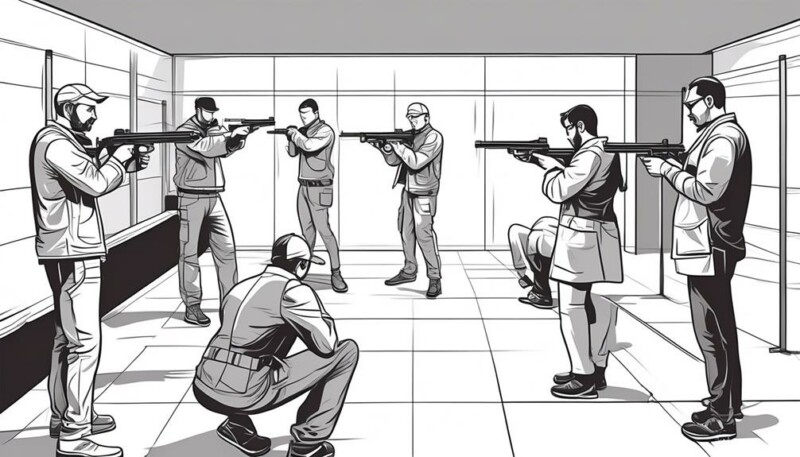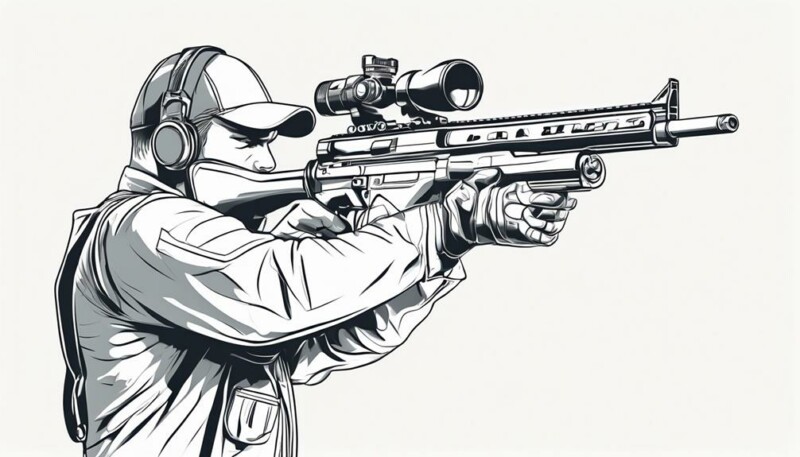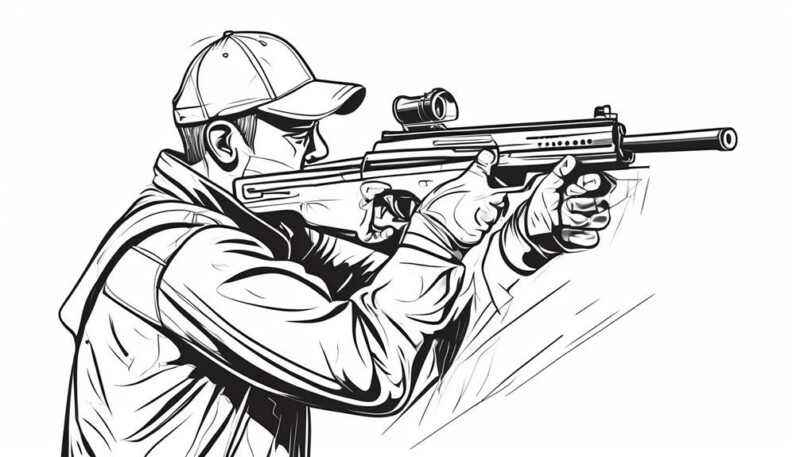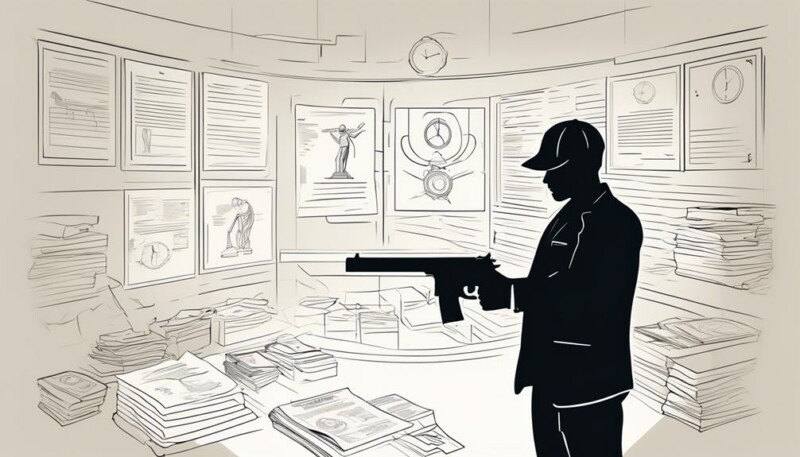In the world we live in today, personal safety and protection have become increasingly important. Whether you're a law enforcement officer, a security professional, or a responsible citizen looking to exercise your right to self-defense, professional concealed carry training is a critical step towards ensuring your preparedness.
But what are the nine key steps that make up this training? How do they equip you with the skills and knowledge you need to confidently carry a concealed handgun?
Well, get ready, because we're about to dive into the essential elements of professional concealed carry training, and you won't want to miss out on what lies ahead.
Key Takeaways
- Understanding and adhering to laws and regulations governing firearm possession is crucial for responsible concealed carry.
- When choosing a firearm for concealed carry, consider state requirements and restrictions, as well as factors like size, weight, and ease of concealment.
- Proper handling and grip techniques are essential for firearm safety and effectiveness.
- Mastering drawing techniques, selecting the right holster, and maintaining discretion in public settings are important aspects of professional concealed carry training.
Safety Rules and Regulations
To ensure safe and responsible concealed carry, it's crucial to understand and adhere to the laws and regulations governing firearm possession in your state. Familiarizing yourself with these laws will help you avoid legal trouble and promote the overall safety of yourself and those around you.
Each state has its own specific laws regarding concealed carry, including where it's prohibited and any exceptions. It's important to know these laws inside and out so that you can carry your handgun in compliance with the law. Additionally, if your state requires a permit for concealed carry, you must meet the age and eligibility requirements to obtain one.
Understanding the prohibited places where carrying firearms isn't allowed is essential for responsible concealed carry. Federal buildings, schools, and private properties with restrictions are some examples of places where carrying a concealed weapon is prohibited. By staying informed and up-to-date on the regulations in your state, you can ensure that you're operating within the boundaries of the law.
Seeking professional training is also highly recommended. Enrolling in a recognized training program will teach you about firearm safety, laws, and self-defense techniques. Remember, responsible concealed carry starts with a solid understanding of the laws and regulations governing firearms in your state.
Choosing the Right Firearm

Understanding the laws and regulations is crucial, but now let's focus on choosing the right firearm for your concealed carry needs. When it comes to concealed carry, selecting the appropriate handgun is of utmost importance. Before making a decision, it's recommended that you first complete a concealed carry training course, as it will provide you with the necessary knowledge and skills to make an informed choice.
When applying for a concealed carry permit, it's essential to consider the specific requirements and restrictions imposed by your state. Some states have limitations on the type of firearms you can carry, such as magazine capacity or caliber restrictions. Familiarize yourself with these regulations to ensure compliance.
Once you have obtained your permit, it's time to consider the factors that will influence your choice of firearm. These factors include size, weight, and ease of concealment. A compact or subcompact handgun is often preferred for concealed carry due to its smaller size and lighter weight, making it easier to carry discreetly.
Additionally, consider the firearm's reliability, accuracy, and ease of use. These qualities are crucial in a self-defense situation where split-second decision-making is required. Take the time to research and test different handguns to find the one that best suits your needs and preferences.
Choosing the right firearm for concealed carry is a decision that shouldn't be taken lightly. By understanding the laws, completing a training course, and carefully considering factors such as size, weight, and reliability, you can ensure that you're well-equipped to protect yourself while carrying discreetly.
Proper Handling and Grip Techniques
Proper handling and grip techniques are essential for ensuring weapon retention and control during concealed carry. Training in these techniques is crucial for both law enforcement officers and individuals carrying a concealed handgun. Here are three key reasons why proper handling and grip techniques are vital:
- Prevent Accidental Discharge: By learning and practicing proper handling techniques, you can minimize the risk of accidental discharge. A secure grip and proper finger placement on the trigger guard can help prevent unintentional firing of the firearm.
- Enhance Firearm Effectiveness: Proper handling and grip techniques enable you to effectively use your concealed handgun in self-defense situations. Maintaining a firm grip on the firearm and practicing a consistent grip technique will enhance your accuracy and control, even in high-stress scenarios.
- Ensure Firearms Safety: Understanding and practicing proper handling and grip techniques are essential for responsible concealed carry practitioners. By following these techniques, you reduce the risk of injury to yourself and others. Additionally, proper handling techniques can help prevent unauthorized access to your firearm.
Professional concealed carry training, including firearms training and qualification courses, emphasizes the importance of consistent and correct grip techniques. By mastering these techniques, you can carry a concealed firearm confidently and responsibly.
Drawing From Concealment

Now it's time to explore the important skills of drawing from concealment.
In this section, you'll learn effective techniques for quickly and safely accessing your concealed firearm when needed.
Additionally, we'll discuss the considerations that come with carrying a concealed weapon, such as clothing choices and maintaining discretion in public settings.
Let's dive into these crucial aspects of concealed carry training.
Effective Draw Techniques
To effectively draw from concealment in a high-stress situation, mastering the proper grip, holster selection, and body mechanics is crucial.
Here are three key elements to consider for effective draw techniques:
- Proper Grip: A firm and secure grip on your firearm is essential for control and accuracy. Ensure your fingers are positioned correctly and maintain a consistent grip throughout the draw.
- Holster Selection: Choosing the right holster is vital for a smooth and efficient draw. Consider factors such as comfort, accessibility, and retention to find a holster that suits your needs and allows for a quick and reliable draw.
- Body Mechanics: Developing proper body mechanics helps optimize your draw technique. Practice drawing from different positions, such as standing, sitting, or kneeling, to ensure you can adapt to various scenarios.
Concealed Carry Considerations
Mastering effective draw techniques is only one aspect of concealed carry training; it's also crucial to consider the specific considerations for drawing from concealment.
When carrying a concealed weapon, it's important to familiarize yourself with the laws and regulations of your state. Each state has its own requirements for obtaining a concealed weapons permit, which is typically issued by the Department of Public Safety or a similar law enforcement agency. The issuance of a permit is often contingent upon passing a background check, which includes a review of your Criminal History Records.
Once you have obtained a permit, it's essential to practice drawing from concealment in a safe and controlled environment. This will help you develop muscle memory and increase your reaction time in real-life situations.
Shooting Fundamentals and Accuracy

To improve your shooting fundamentals and accuracy, there are three key points you need to focus on.
First, mastering proper grip technique is crucial as it provides stability and control over your firearm.
Second, sight alignment plays a vital role in hitting your target accurately, so ensure that your front and rear sights are aligned perfectly.
Lastly, practicing proper trigger control techniques will help you maintain steady aim and prevent unnecessary movement when pulling the trigger.
Proper Grip Technique
Proper grip technique is crucial for mastering shooting fundamentals and achieving accuracy. To ensure a proper grip, follow these guidelines:
- Firm but not tense hand placement: Place the web of your dominant hand high on the backstrap of the firearm, providing stability and control.
- Support hand placement: Wrap your support hand around the dominant hand, interlace your fingers, and apply pressure inward and forward for added stability.
- Thumb and trigger finger placement: Stack your thumbs and place your trigger finger naturally on the trigger, ready to engage when necessary.
Sight Alignment Importance
Now that you have established a firm grip technique, it's important to understand the significance of sight alignment in shooting fundamentals and achieving accuracy.
Sight alignment involves aligning the front and rear sights with the target. This ensures that the bullet will impact the target where the sights are aligned. Proper sight alignment requires consistency and precision. It's crucial to understand the relationship between the front and rear sights to achieve accurate shots.
Sight alignment is a fundamental skill that forms the basis for shooting accuracy. Instructors in concealed carry training emphasize the importance of sight alignment to ensure that individuals carrying concealed firearms have the necessary skills to shoot accurately and responsibly.
Meeting the standards set by public law, instructors may use live scan technology to evaluate and improve sight alignment proficiency.
Trigger Control Techniques
Improve your shooting accuracy and precision with effective trigger control techniques. Here are three key aspects to focus on:
- Finger placement: Proper finger placement on the trigger is crucial. Your finger should be positioned on the trigger pad, not the joint. This allows for a consistent and controlled trigger pull.
- Gradual pressure: Applying gradual and consistent pressure on the trigger is essential. Avoid jerking or flinching, as it can negatively impact your aim. Smoothly press the trigger straight back to maintain accuracy.
- Training and practice: Mastering trigger control requires practice and training. Enroll in a professional concealed carry training program, where a Firearms Instructor can provide guidance and feedback. Regular practice will help you develop muscle memory and improve your shooting fundamentals.
Tactical Decision-Making and Situational Awareness

Developing tactical decision-making skills and situational awareness is crucial for ensuring personal safety in concealed carry situations. In professional concealed carry training, emphasis is placed on honing these skills to effectively handle real-world self-defense scenarios.
Tactical decision-making involves assessing potential threats and determining the best course of action to ensure personal safety. This includes recognizing pre-attack indicators and understanding the OODA loop (observe, orient, decide, act).
Situational awareness, on the other hand, is the ability to observe, understand, and anticipate the environment to proactively respond to potential dangers. It requires continuous scanning of the surroundings, understanding spatial relationships, and being mindful of potential escape routes.
The Peace Officer Standards and Training (POST) program in the United States provides guidelines and standards for law enforcement officers, including training in tactical decision-making and situational awareness.
However, even if you aren't a peace officer, it's essential to possess these skills when you carry a concealed firearm. Before doing so, it's crucial to familiarize yourself with your state laws. Contact your local law enforcement agency or consult your state law to ensure that you're legally allowed to possess a firearm and carry it concealed.
Defensive Shooting Techniques

To effectively neutralize threats in real-world self-defense scenarios, concealed carry holders must master defensive shooting techniques. These techniques focus on quick target acquisition and accurate shot placement to quickly and efficiently neutralize an assailant.
Here are three key elements of defensive shooting techniques:
- Practicing shooting from various positions: It's essential for concealed carry holders to practice shooting from different positions, including standing, kneeling, and prone. This allows them to adapt to different scenarios and engage threats effectively.
- Proper use of cover and concealment: Concealed carry holders need to understand how to effectively utilize cover and concealment to protect themselves while engaging an assailant. This involves knowing the difference between cover (objects that can stop bullets) and concealment (objects that can hide you from view).
- Training for stress management and split-second decision making: Defensive shooters must be trained to handle stress and make split-second decisions in high-pressure situations. They should also be prepared to deal with potential threats in crowded or public spaces, where bystanders may be present.
Legal Considerations and Self-Defense Laws

Before carrying a concealed weapon, it is crucial to understand the specific regulations and self-defense laws in your state. The laws regarding carrying a firearm vary by jurisdiction, so it is essential to be familiar with the requirements and restrictions that apply to you. To help you navigate these legal considerations, here is a table outlining some key points to keep in mind:
| Legal Considerations | Laws Regarding Carrying a Firearm |
|---|---|
| Concealed Carry Permits | A permit issued by the state is often required to carry a concealed weapon. The eligibility criteria for obtaining a permit may include age restrictions, background checks, and completion of specific training or safety courses. |
| Prohibited Locations | Certain places, such as courthouses, schools, and federal buildings, prohibit carrying firearms. Familiarize yourself with these prohibited locations to avoid legal trouble. |
| Resident vs. Non-Resident | Concealed carry laws may differ for residents and non-residents. Make sure you are aware of any restrictions or conditions that apply when traveling to other states. |
| Law Enforcement Objection | In the event of a law enforcement objection or challenge, it is important to know the process for addressing and resolving the objection to navigate the concealed carry permit application process effectively. |
Frequently Asked Questions
What Are the Different Types of Holsters Available for Concealed Carry?
There are different types of holsters available for concealed carry, each with its own advantages. When choosing the right holster, consider your body type and clothing style.
Appendix carry holsters are popular for their accessibility, while shoulder holsters offer a different option. It's important to find a holster that fits your needs and preferences, ensuring you can comfortably and safely carry your firearm.
How Often Should I Practice Drawing My Firearm From Concealment?
To ensure your firearm skills are sharp, practice drawing from concealment regularly. Practice frequency is key to building muscle memory and improving your draw speed.
However, make sure to prioritize firearm safety during your practice sessions. Focus on maintaining a proper grip, developing situational awareness, and mastering defensive shooting techniques.
Remember to also practice your shooting stance for accuracy and control.
Are There Any Specific Shooting Drills That Can Help Improve Accuracy?
To improve your accuracy, there are specific shooting drills you can practice. These techniques focus on target acquisition, grip control, sight alignment, trigger control, breathing techniques, and follow-through techniques.
Incorporating these drills into your training routine will help you develop the necessary skills for accurate shooting. Remember to practice regularly to maintain proficiency.
What Are Some Common Mistakes Made by Concealed Carry Holders and How Can They Be Avoided?
Common mistakes can be avoided by following a few key techniques.
- Ensure a proper grip on your firearm and choose a holster that allows for a smooth draw.
- Practice drawing regularly to develop muscle memory and speed.
- Improve accuracy by incorporating shooting drills into your training routine.
- Consider obtaining advanced certifications to further enhance your skills.
Are There Any Additional Training Courses or Certifications That Can Enhance My Concealed Carry Skills Beyond the Basics?
If you're looking to enhance your concealed carry skills beyond the basics, there are advanced courses and certifications available. These can provide you with tactical training, self-defense techniques, and improve your situational awareness.
Advanced courses also focus on defensive shooting skills, firearm maintenance, and legal considerations. By investing in additional training, you can further develop your abilities and confidence in carrying concealed firearms.
Conclusion
So, now you're equipped with the knowledge and skills to pursue professional concealed carry training. Remember, safety is paramount, and understanding the laws and regulations is crucial.
Did you know that in the United States, there are over 18 million concealed carry permit holders? That's a significant number of individuals who've taken the steps to ensure their safety and the safety of those around them.
Stay informed, stay prepared, and stay safe.
